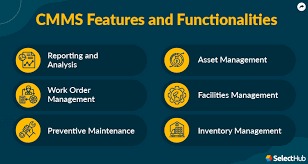With the instant pace of things nowadays, a top-notch maintenance management solution (MMS) is required now more than ever. Research shows that in the last three years, 82% of organizations have gone through an unplanned downtime due to one or more hardware failures, highlighting how crucial maintenance tools are needed not only as a means for prevention but also to avoid operational unseen and financial losses.[1]
Today, maintenance department software releases have come to include additional important capabilities that are specifically aimed at optimizing hardware performance, prolonging service life, and eliminating unplanned downtime. These are essential parts each MMS must have, by following which companies can work productively and safely.
What are the types of Maintenance Management Software?
Maintenance management software creates an environment where maintenance of your machinery and assets runs smoothly. It is not just a tool but it tells a complete story of when you need maintenance and when an asset is creating problems. It acts as a strategic partner and handles the planning and coordination of every machine.
Here are some needful features mentioned below:
1. Predictive Maintenance
MMS with prescient abilities assists organizations with expecting issues, improving upkeep plans, and keeping away from superfluous expenses. Organizations are permitted by prescient maintenance to perform maintenance just when important.
This information-driven approach provides:
-Chiefs with insights into gear wellbeing.
– Lessen functional expenses.
-Empowering officials to pursue informed choices and lessen startling breakdowns.
Taking upkeep to a higher level, predictive maintenance depends on constant information from IoT sensors to foresee gear disappointments before they occur.
2. Mobile Accessibility
Maintenance groups are in many cases progressing, particularly in enormous offices.
A mobile-empowered MMS furnishes:
– Professionals with admittance to the product on their cell phones or tablets.
– On-location admittance to hardware manuals and support history.
-Take into consideration the continuous updates and expanded efficiency.
This element empowers quicker reaction times and guarantees professionals have all the data they need readily available. Versatile access offers continuous updates on work orders and quick warnings of issues or margin times.
3. User-Accommodating Interface
A well-designed UI provides quick access to essential features and customization options based on user roles. After all, even the best software is of no use if it is difficult to work with.
A decent MMS ought to have:
– An easy-to-use interface.
– Way of managing frustration naturally
-Ensuring ease of route and little prep time.
Simply by simplifying the usage of the framework, can institutions better increase user adoption and ensure that service tasks are completed efficiently.
4. Complete Resource Management
Dealing with a gigantic exhibit of assets can be overpowering, particularly in gathering or enormous degree ventures.
A strong MMS gives:
– Centralized asset management
-It encapsulates all the assets like machines and materials in a single information aggregation.
– It provides transparency to the life cycle, performance, and maintenance needs of every asset.
With an asset in the executive’s system, clients can follow asset life cycles and upkeep history. This simplifies it for office bosses to expect dismay, improve asset use, and plan for upgrades or replacements without making any utilitarian misfortunes.
5. Compliance Management
Numerous businesses are represented by severe guidelines for hardware support and well-being. An MMS with compliance management guarantees that all fundamental documentation is kept up and the administrative necessities are met.
Highlights include:
– Programmed generation of documentation.
– Following administrative assessments.
– Guaranteeing upkeep satisfies administrative guidelines.
This makes it simpler to pass reviews and diminishes the risk of fines or punishments for non-compliance.
6. Integration With Other Systems
A maintenance record software should incorporate consistently with other business frameworks, for example, undertaking asset arranging programming, monetary devices, and IoT stages. This guarantees data consistency and empowers smooth work processes between divisions.
The integration gives advantages, for example,
– Smoothed out acquisition and monetary following.
– Upgraded information dividing among support and creation groups.
– A better joint effort between various business capabilities.
This empowers a more proficient and bound together way to deal with upkeep and business tasks.
7. Customization And Scalability
Each association has various necessities. A compelling MMS ought to offer customization options that permit organizations to tailor work processes, detailing, and access controls to suit their particular necessities.
Furthermore, the framework should be scalable to deal with development, obliging expanded asset numbers and more perplexing frameworks without forfeiting execution.
8. Safety And Hazard Management
Guaranteeing specialist wellbeing is a first concern in support tasks. A decent MMS ought to highlight safety and risk management devices to follow security conventions, consistency, and episodes.
These devices permit organizations to:
– Screen security investigations.
– Oversee security conventions for errands.
– Track and log security episodes for future examination.
By coordinating wellbeing management with upkeep, organizations can diminish the risk of mishaps and guarantee a more secure workplace.
9. Cloud-Based Capabilities
Cloud-based MMS arrangements offer adaptability and cost viability over conventional on-premise frameworks. With a cloud-based MMS, organizations can get to upkeep information from any place and benefit from automatic refreshes without putting resources into costly foundations.
Benefits of cloud-based MMS include:
– Remote access.
– Programmed refreshes.
– Lower forthright expenses.
– Versatility without the requirement for equipment ventures.
This guarantees ceaseless activity and limits disturbances during framework overhauls.
10. Cost Management
Following maintenance costs is basic for remaining inside the spending plan. A MMS with cost management characteristics gives detailed knowledge/insight into labor, parts, and hardware costs.
By observing expenses, office directors can:
– Dissect spending designs.
– Enhance asset distribution.
– Distinguish regions for cost investment funds.
Successful expense management guarantees that support tasks stay productive without overspending.
11. Equipment Support Tracking
A basic capability of any MMS is the capacity to log and track equipment support history. This gives significant insights into past fixes, substitutions, and overhauls, assisting directors with anticipating future necessities.
Hardware following aids organizations to:
– Further, develop gear dependability.
– Anticipate future upkeep prerequisites.
– Follow guarantees and administration arrangements.
By having detailed upkeep records, organizations can settle on informed conclusions about equipment substitutions and speculations.
Benefits Of Maintenance Management Software
Maintenance management software provides many advantages and proves to be very useful in our lives.
-First of all it reduces the risk and increases the uptime of the equipment. Due to timely preventive maintenance, breakdowns also reduce.
-You can easily access your work orders and equipment history and this is another advantage. All maintenance records are located in one centralized location and it also streamlines your operations.
-The third benefit is compliance. This simplifies meeting regulatory standards. Thus, maintainingaccurate maintenance records helps you pass audits easily.
–Maintenance management software also gives you the benefit of making your equipment work smoothly for a longer period of time without major issues and your replacement and repair costs also get reduced.
Advantages of Picking LLumin for Maintenance Management Software: A New Viewpoint
When it comes to maintenance management software, LLumin’s extraordinary features are designed to revolutionize your operations and deliver real and tangible benefits. In more ways than one, It transcends the typical formula. That is one sort of take if your business looks to strengthen the basic parts mentioned earlier, which puts some emphasis on why LLumin would be a perfect fit.
Proactive Maintenance: Prevent The Problem Before It Happens
LLumin’s predictive maintenance feature does not wait for the device to fail, it corrects problems before they exist. LLumin detects problems early and sends alerts by continuously disassembling the equipment information, which allows maintenance teams to respond promptly. This proactive approach, can significantly reduce unplanned downtime and ensure operations flow as planned.
For example, visualize a factory operating 24/7. Those inspections continue after production begins, but an initial quality control check sends out a small vibration variation in one of its basic machines The team receives an alert, corrects it before a crash occurs, and stops the downtime that could have been expensive, keeping tasks moving along as expected.
Example: Envision an assembling office running every minute for every day. With LLumin’s ongoing checking, a slight vibration irregularity in a basic machine is recognized early. The maintenance group gets an alarm, makes fixes before disappointment happens, and forestalls a closure that might have cost thousands in lost creation.
Seamless Reconciliation With Existing Systems
One of LLumin’s champion highlights is its capacity to incorporate flawlessly with your current ERP and monetary frameworks. Whether it’s connecting with your stock administration or computerizing work orders, LLumin guarantees that each of your frameworks works together as one, making a brought-together work process.
Example: In a worldwide coordinated operations organization, incorporating LLumin with the current ERP permitted the maintenance group to follow the lifecycle of conveyance trucks across different areas. This consistent combination worked on fleet dependability and decreased fix delays, keeping conveyances on time.
Real-Time Observing For Immediate Action
One of LLumin’s key benefits is its constant checking framework. By consistently following hardware execution, LLuminfurnishes support groups withcutting-edge data, permitting them to make a quick move on the off chance that something turns out badly.
Example: In a synthetic plant, LLumin’s constant observing hailed an expansion in temperature on a vital machine. Upkeep groups acted quickly to change the framework before it prompted a risky overheating circumstance, keeping away from personal time and guaranteeing security.
Enhanced Joint Effort Across Teams
LLumin advances better correspondence and joint effort by keeping all support information in one spot. Directors, experts, and acquisition groups can get similar data continuously, guaranteeing that everybody is in total agreement and that errands are finished productively.
Example: An enormous energy organization utilized LLumin to make a common stage for its support and obtainment groups. At the point when a machine required a section substitution, the obtainment group could quickly see the solicitation, request the part, and track its conveyance status in a similar framework, lessening defers in fixes.
Data-Driven Choice Making
LLumin enables organizations to pursue more intelligent choices through its high-level examination and announcing devices. Chiefs can follow key performance indicators (KPIs) like margin time, fixed expenses, and resource life expectancy, and utilize this information to improve support procedures.
Example: After a year of LLumin’s usage, a service organization saw that a similar piece of equipment had separated more than once. By examining the information, they found that a specific part was broken down quicker than anticipated. They changed to a greater part, lessening breakdowns by 30%.
Pricing Plans
-
- Lean Starter/Plan A: Ideal for new businesses; This plan gives fundamental elements like resource following and essential upkeep booking, without pointless intricacy.
- Growth Focus/Plan B: Ideal for developing organizations; This plan incorporates prescient support instruments and constant announcing, permitting moderate-sized groups to oversee tasks without added complexities.
- Master Suite/Plan C: Outfitted towards huge endeavors; This thorough bundle offers full customization, computer-based intelligence-controlled insights, and consistent combination with existing frameworks, all upheld by premium-level client support.
These plans are intended to adjust as your business advances, guaranteeing smooth and proficient inventory and maintenance software.
Conclusion
In the present serious business climate, decreasing margin time, upgrading resource lifecycles, and overseeing functional expenses are fundamental for progress. Maintenance manager softwarefurnished with the right highlights assists organizations with accomplishing these objectives by further developing proficiency, diminishing impromptu downtime, and guaranteeing consistency with well-being and administrative norms. Putting resources into a complete MMS guarantees that organizations can boost the life expectancy and unwavering quality of their resources, all while keeping tasks running along as expected.
FAQ’S
1. Is it safe to invest in maintenance management software?
Putting resources into maintenance management software resembles giving your equipment a well-being examination before issues emerge. It changes responsive fixes into proactive consideration, decreasing startling breakdowns. By dissecting designs, it predicts future upkeep needs, forestalling exorbitant failures.
2. How important is implementation when selecting a CMMS solution?
Execution is essential when choosing a CMMS arrangement. A top-notch execution guarantees smooth joining with existing frameworks, legitimate preparation for clients, and customization to address explicit issues. A solid execution can be the deciding moment of the product’s prosperity.
3. What are the top CMMS KPIs one should be tracking?
Top CMMS KPIs to follow incorporate Mean Time To Repair (MTTR) for surveying fix proficiency, Mean Time Between Failures (MTBF) to measure gear dependability, and upkeep expenses per resource for control costs. Furthermore, track work request consummation rate to screen task execution and personal time to quantify the effect of upkeep on activities.






